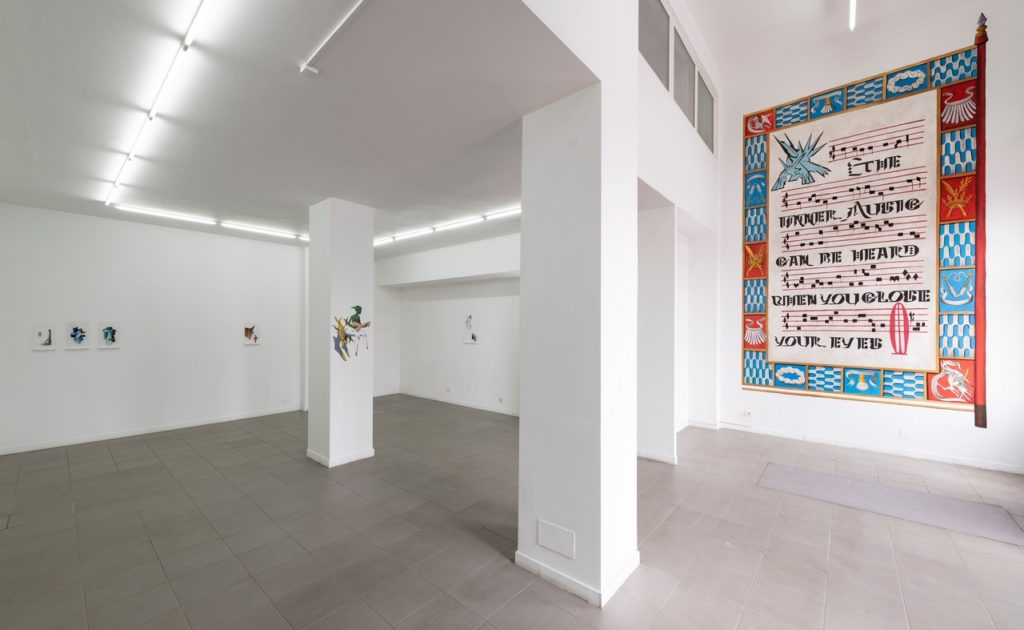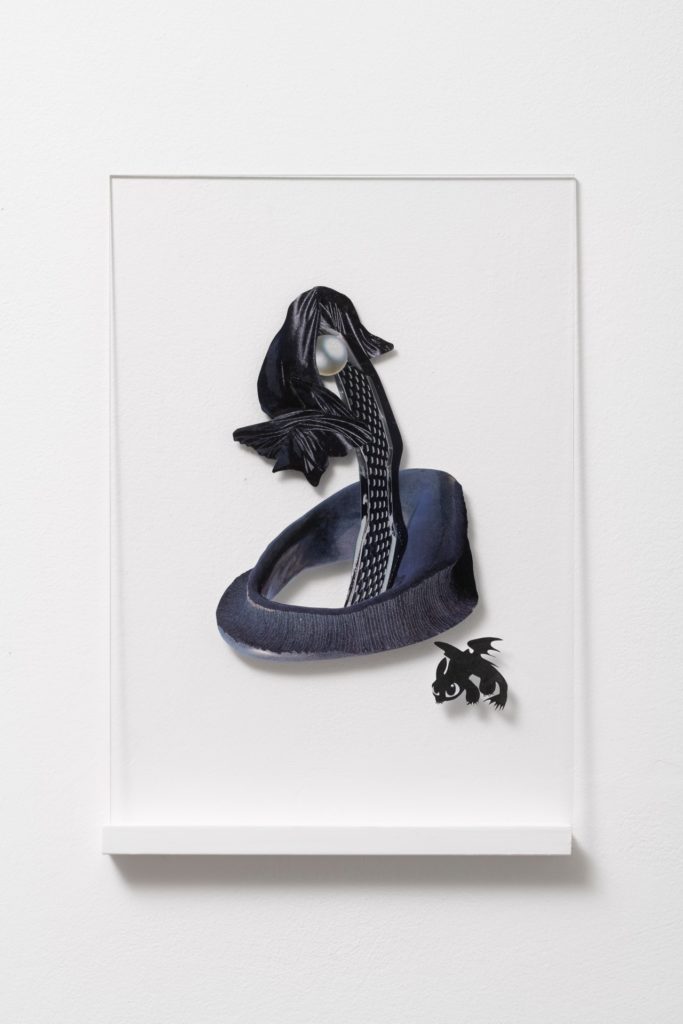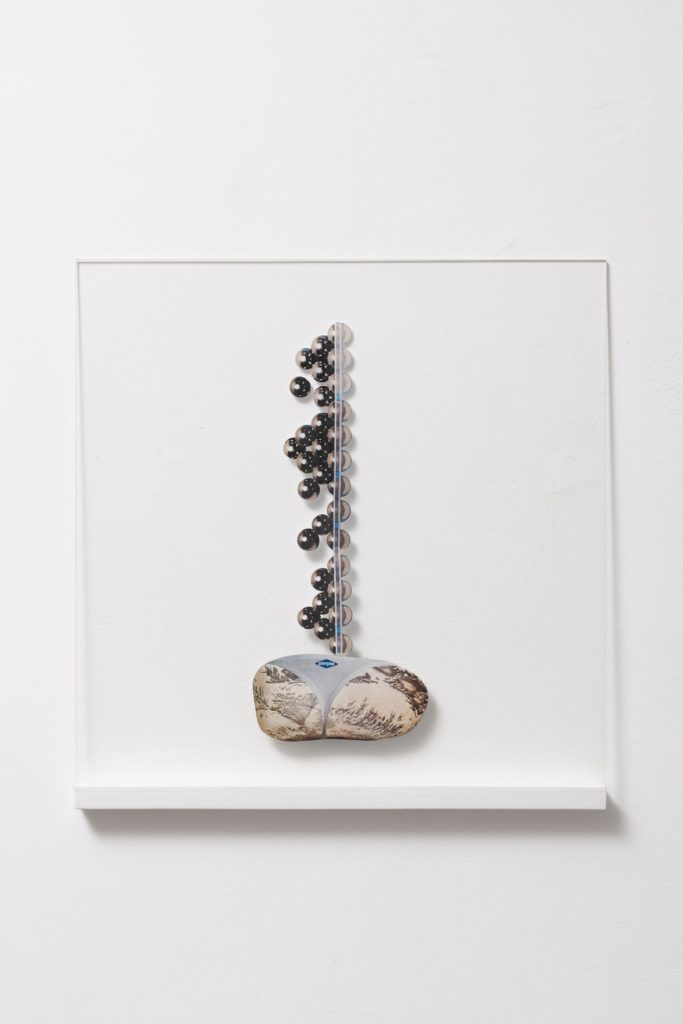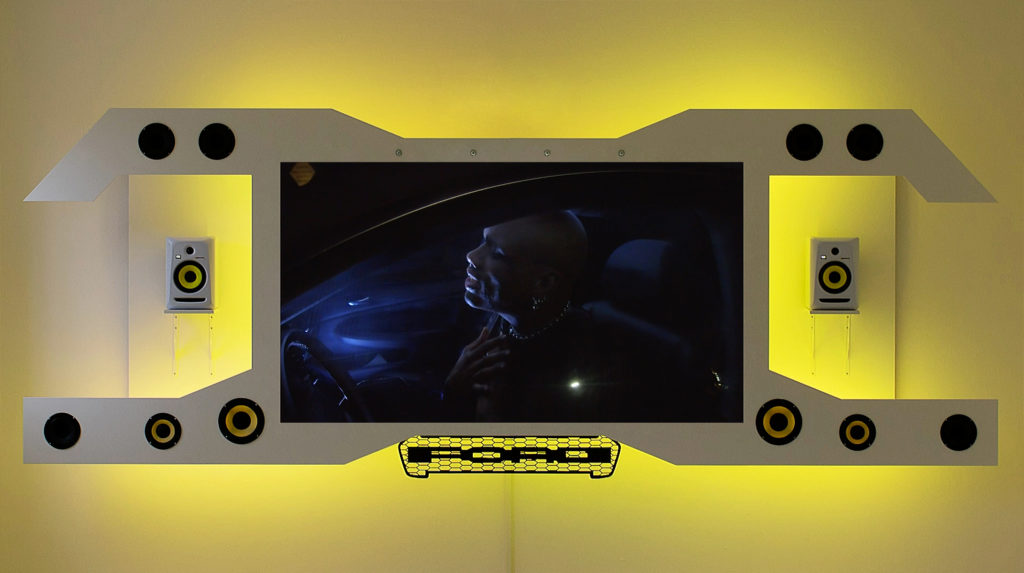Sinae Yoo
13.05.2019 – 21.06.2019
Exhibition views

Petrichor, 2019, video installation, HD video and sound, 160,5 x 439,5 cm, photo by Giorgio Benni 
Petrichor, 2019, installation view at The Gallery Apart (basement), photo by Giorgio Benni 
Petrichor, 2019, installation view at The Gallery Apart (stairs), photo by Giorgio Benni 
Petrichor, 2019, installation view at The Gallery Apart (ground floor), photo by Giorgio Benni 
Petrichor, 2019, installation view at The Gallery Apart (ground floor), photo by Giorgio Benni 
Petrichor, 2019, installation view at The Gallery Apart (ground floor), photo by Giorgio Benni
Works

Danse macabre “Dance of Death”, 2019, wall painting, 68×54 cm, photo by Giorgio Benni
Martyr #3, 2019, collage, 30 x 21 cm, photo by Giorgio Benni
Martyr #2, 2019, collage, 45 x 24 cm, photo by Giorgio Benni 
Martyr #2, 2019, collage, 45 x 24 cm, photo by Giorgio Benni 
Martyr #3, #2, #1, 2019, collage, variable dimensions, photo by Giorgio Benni 
Martyr #4, 2019, collage, 45 x 29,5 cm, photo by Giorgio Benni 
Memento Mori #2, 2019, collage, 58 x 43 cm, photo by Giorgio Benni 
Memento Mori #1, 2019, collage, 45 x 30 cm, photo by Giorgio Benni 
Gray Moral Sludge #, 2019, collage, 43 x 43 cm, photo by Giorgio Benni
Memento Mori #3,2019, collage, 45 x 25 cm, photo by Giorgio Benni 
The inner music can be heard when you close your eyes, 2019, wall painting, stickers, detail, photo by Giorgio Benni
Petrichor, 2019, video installation, HD video and sound, 160,5 x 439,5 cm, photo by Giorgio Benni 
Petrichor, 2019, video installation, HD video and sound, 160,5 x 439,5 cm 
Petrichor, 2019, video installation, HD video and sound, 160,5 x 39,5 cm
The Gallery Apart is proud to present Petrichor, the second solo show by Sinae Yoo (Seoul, 1985) hosted in the gallery spaces. Exploring the sensory imagery of Sinae Yoo means living a sensory experience of great visual impact and which soon morphs into a meeting with themes, suggestions and requests related to ethical and moral foundations which since ever have compelled human beings to question themselves and the environment where their earthly life unfolds. In the last few years, by exploiting a wide range of media, Sinae Yoo has investigated topics such as estrangement and bondage under the yoke of capitalism. Drawing on the visual culture as a defining part of advertising and video games, the artist evokes an aesthetic form of seduction which ensnares and shatters the souls in its virtual network.
The exhibit unfolds around the video installation that lends its title to the show. Petrichor is a word coined by some scientists during the Sixties to describe the distinct scent when a storm’s first raindrops hit the ground after a long period of dry weather. The video is the result of a close cooperation with a community of artists whom Sinae Yoo met in the city of Baltimore, where the artist lived during the last year and where the video has been shot. The film features Elon Batlle, the composer and singer Mathew Starke, and the poet Keenon Brice, while Alex Deranian and Sylvain Gerboud composed its soundtrack.
Set in service stations and in car parks, Petrichor revolves around the car as an emblematic object of a regulatory, hyper-masculinized power. A world controlled and inhibited by the lean curves and by the powerful audio system of a muscle car. The artist uses subculture products to investigate the mechanisms which govern personal relationships and the relation with the expressions of the self which, in the capitalist system, are based on forms of extreme competitiveness. Capitalism, in fact, does not promise any salvation or redemption for the weak, but only default and debt, and in art, just like at work, the mainstream exploits and destroys the free subcultures, imposing submission, obedience and conformity to the dominant aesthetic canons.
The protagonists of Petrichor seek to escape this by giving life to scenes where music and drama serve as catalyst for emancipation, resilience and fortitude. The rebellion against the imposed uniformity goes through the exaltation of a space and of shared social practices, of a sociological habitus which here is defined “Glass flex”, a subculture where the affirmation of identity and the social recognition is based on a competition over the biggest in-car audio system, over who has the most powerful subwoofers. The video installation and its score are inspired by such hyper-masculinized aesthetics.
Music plays a key role in the project Petrichor. The song “Shield” borrows the music that, in a stunning detail of the tryptich oil painting “The Garden of Earthly Delights”, housed in the Museo del Prado in Madrid, Hieronymus Bosch painted upon the posterior of one of his innumerable upsetting figures. The result is a completely new song that one of the protagonists featuring in the video sings, which however the spectators cannot hear. The song indeed is played on the upper floor of the gallery where the audience will listen to it while having the big mural work of art in front of them that Sinae Yoo has painted on the highest wall of the gallery, and on which the artist wrote “Inner music can be heard when you close your eyes”. It invites to rediscover the spiritual dimension that the consumerist society tends to reject. The abstract collages featuring the exhibition are inspired by such dimension and by its possible and personal visual representation.
The Gallery Apart è orgogliosa di presentare Petrichor, la seconda personale di Sinae Yoo (Seoul, 1985) negli spazi della galleria. Addentrarsi nell’immaginario di Sinae Yoo significa apprestarsi ad un’esperienza sensoriale dal forte impatto visuale e che presto si trasforma in un incontro con temi, suggestioni e istanze che attengono ad alcuni fondamenti etici e morali che da sempre obbligano il genere umano ad interrogare se stesso e l’ambiente in cui si dipanano le sue vicende terrene. Negli ultimi anni, usando una vasta gamma di media, Sinae Yoo ha esplorato temi quali l’alienazione e la servitù sotto il giogo del capitalismo. Prendendo spunti dalla cultura visiva della pubblicità e dei videogiochi, l’artista evoca un’estetica di seduzione che intrappola e frantuma le anime nella sua rete virtuale.
La mostra si sviluppa intorno all’installazione video che le dà il titolo. Petrichor è un termine coniato in ambito scientifico nel corso degli anni ’60 per indicare l’odore che si manifesta quando una prima pioggia cade dopo un lungo periodo di bel tempo. Il video è il risultato di un processo di stretta collaborazione con una comunità di artisti che Sinae Yoo ha incontrato a Baltimora, città dove l’artista ha risieduto nel corso dell’ultimo anno e dove il video è stato girato. Recitano nel film Elon Batlle, il compositore e cantante Mathew Starke e il poeta Keenon Brice, mentre Alex Deranian e Sylvain Gerboud ne hanno composto la colonna sonora.
Ambientato in stazioni di servizio e parcheggi, Petrichor si concentra sull’automobile come oggetto emblematico di un potere normativo iper-mascolinizzato. Un mondo controllato e inibito dalle curve slanciate e dal potente sistema audio di una muscle car. Si tratta di sottoprodotti culturali che l’artista utilizza per indagare i meccanismi che presiedono alle relazioni interpersonali e al rapporto con le espressioni del sé che nel sistema capitalistico sono improntate a forme di estrema competitività. Il capitalismo infatti non promette salvezza e redenzione per i deboli, ma solo default e debito e nell’arte, come nel lavoro, il mainstream sfrutta e distrugge le sottoculture libere imponendo sottomissione, obbedienza e conformità ai canoni estetici dominanti.
I protagonisti di Petrichor tentano di sfuggire a tutto ciò dando vita a scenari in cui musica e teatralità fungono da catalizzatori per l’emancipazione, la resilienza e la forza d’animo. La ribellione all’uniformità imposta transita per l’esaltazione di uno spazio e di pratiche sociali condivise, di un habitus in senso sociologico che qui assume la denominazione di “Glass flex”, una sottocultura in cui l’affermazione identitaria e sociale è affidata a una gara a chi costruisce i sistemi audio per automobili più smisurati, a chi detiene i subwoofers più potenti. E’ a questa estetica ipermascolinizzata che si ispirano l’installazione video e la colonna sonora.
La musica gioca un ruolo fondamentale nell’ambito del progetto Petrichor. La canzone “Shield” prende a prestito le note musicali che, in uno straordinario particolare del Trittico del Giardino delle delizie, conservato al Museo del Prado di Madrid, Hieronymus Bosch dipinge sul sedere di una delle sue infinite inquietanti figure. Ne è derivata una canzone completamente nuova che uno dei protagonisti del video canta senza che però lo spettatore la possa sentire. La canzone in effetti viene diffusa al piano di sopra della galleria dove lo spettatore la ascolterà avendo negli occhi il grande murale che Sinae Yoo ha dipinto sulla parete più alta della galleria e in cui ha inserito la frase “La musica interiore può essere ascoltata quando chiudi gli occhi”. E’ un invito a recuperare la dimensione spirituale che la società materialista tende ad espellere ed è a questa dimensione e alla sua possibile e personale rappresentazione visuale che si ispirano i collages astratti che completano la mostra.
all photos by Giorgio Benni
share on